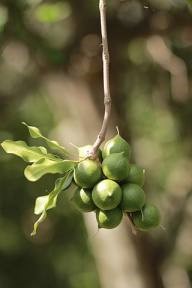Macadamia
Scientific Name: Macadamia integrifolia
Climate: Warm and temperate
Plant Description: It is a tree from 2 to 12 m high. It has dark green, long, wider in half oval leaves that also can be tear shaped. They grow from a single point in a circular pattern. The flowers are white to pink with “tassels” and are very small. They grow in long chainlike clusters. The nuts form in a leathery case about 2.5 cm wide. It is grown in regions of height from 0 to 1200 amsl
Its natural range is limited to eastern Australia, New Caledonia, Indonesia and Celebes. Currently, macadamia is also grown in Mexico, Bolivia, Colombia, Costa Rica, Guatemala, Ecuador, Paraguay, Dominican Republic, Venezuela, South Africa and Madagascar.
Cultivation: The ideal temperature for Macadamia is 16 to 25 ° C. In temperate climate, without frost, with abundant rainfall distributed throughout the year. Exposure to full sun is preferred, but it also grows in shady places. The lack of water limits the growth of the tree, as well as the growth and quality of the nuts.
Macadamias can grow successfully in areas where there are avocados, papayas, mangoes and bananas. In addition, can be grown simultaneously with other crops. It can be part of the cornfield, sown together with coffee. In the first 2 years of cultivation it can be sown with blackberry, peach, guava, habanero pepper.
Macadamia requires regular watering throughout its life, especially at the stage when the fruit is forming. Most types of soils are suitable for the production of this tree, just be careful that they are not compacted soils. Fertilize after a year after planting. Macadamia trees are very sensitive to root damage, therefore, each fertilizer application must be followed by light watering.
To reproduce the plants by seed, it is necessary to crush the husk to accelerate germination, it must be put in a pot in a hot greenhouse in spring (March-April) or early autumn (September-October). The seed will germinate 4 to 8 weeks after sowing.
It should be transplanted in late spring or early summer, when the frost time is over. The soil should be loosen as deeply as possible. If the soil is compacted in the planting holes, the roots could become rootbound. Do not fertilize recently planted trees. First they must be well established and grow vigorously. It is advisable to wait a year before applying the fertilizer.
It is recommended to protect it from frost and winds. Macadamia requires between 5 and 12 years to start producing fruit, and reaches maximum production at the age of 15. They produce for about 40 years. Lack of water and nutrients can cause a slow growth of the fruit, affect the formation of the oil, the size of the fruit and therefore the quality of the macadamia nuts.
Because most soils are naturally low in zinc, it should be applied once a year. The following concentrations are recommended: zinc oxide at 200 g / 100 l of water
Macadamia nuts fall from the trees when they are ripe and then collected from the ground. Harvest usually occurs from March to July.
 Uses: Macadamia is used as food and also in the production of cosmetics, as it contributes to the hydration of the skin. They are high in fat and low1 in carbohydrates.
Uses: Macadamia is used as food and also in the production of cosmetics, as it contributes to the hydration of the skin. They are high in fat and low1 in carbohydrates.
Pests and Diseases: The fruit is resistant to pests due to its hardness. However, nut kernels without shells are susceptible to infestation, for this reason precautions should be taken in storage areas keeping it clean.
References:
- https://www.nda.agric.za/docs/macadamia/macadamia.htm
http://macadamiamexico.com/wp-content/uploads/2016/06/Manualmacadamia.pdf
En español: Macadamia

